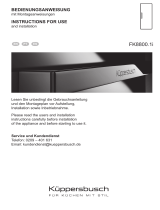
CAUTION!
In the event of accidental
defrosting, for example due
to a power failure, if the
power has been off for
longer than the value shown
on rating plate under "rising
time", the defrosted food
must be consumed quickly
or cooked immediately then
cooled and then re-frozen.
Refer to "High temperature
alarm".
5.7 Thawing
Deep-frozen or frozen food, prior to
being consumed, can be thawed in the
refrigerator or inside a plastic bag under
cold water.
This operation depends on the time
available and on the type of food. Small
pieces may even be cooked still frozen.
5.8 Ice-cube production
This appliance is equipped with one or
more trays for the production of ice-
cubes.
Do not use metallic
instruments to remove the
trays from the freezer.
1. Fill these trays with water.
2. Put the ice trays in the freezer
compartment.
5.9 Cold accumulators
This appliance is equipped with cold
accumulators which increase storage
time in the event of a power cut or
breakdown.
To ensure the best performance of the
accumulators, place them in the front top
area of the appliance.
6. HINTS AND TIPS
6.1 Hints for energy saving
• Freezer: The internal configuration of
the appliance is the one that ensures
the most efficient use of energy.
• Fridge: Most efficient use of energy is
ensured in the configuration with the
drawers in the bottom part of the
appliance and shelves evenly
distributed. Position of the door bins
does not affect energy consumption.
• Do not remove the cold accumulators
from the freezer basket.
• Do not open the door frequently or
leave it open longer than necessary.
• Freezer: The colder the temperature
setting, the higher the energy
consumption.
• Fridge: Do not set too high
temperature to save energy unless it
is required by the characteristics of
the food.
• If the ambient temperature is high and
the temperature control is set to low
temperature and the appliance is fully
loaded, the compressor may run
continuously, causing frost or ice
formation on the evaporator. In this
case, set the temperature control
toward higher temperature to allow
automatic defrosting and to save
energy this way.
• Ensure a good ventilation. Do not
cover the ventilation grilles or holes.
• Make sure that food products inside
the appliance allow air circulation
through dedicated holes in the rear
interior of the appliance.
6.2 Hints for freezing
• Activate Frostmatic function at least
24 hours before placing the food
inside the freezer compartment.
• Before freezing wrap and seal fresh
food in: aluminium foil, plastic film or
bags, airtight containers with lid.
• For more efficient freezing and
thawing divide food into small
portions.
• It is recommended to put labels and
dates on all your frozen food. This will
help to identify foods and to know
when they should be used before their
deterioration.
• The food should be fresh when being
frozen to preserve good quality.
Especially fruits and vegetables
www.aeg.com14




















